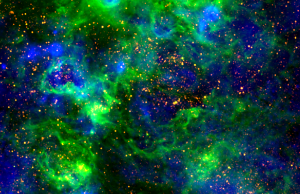Multi-phase Interstellar Medium
The interstellar space between stars and stellar remains in galaxies is filled with cool clouds (T < 100 K) of molecules and neutral atoms with densities of n > 10 cm-3, embedded in warm (T ≃ 10000 K, n ≈ 0.1 cm−3) inter-cloud medium of neutral or partially ionized hydrogen. In addition, UV and X-ray observations have revealed the presence of hot ionized gas at temperatures of T ≈ 106 K. The hot phase is mainly created by massive OB stars, which inject energy into the interstellar medium (ISM) through their radiation, stellar winds, and finally, by supernova explosions. Stars are born in associations or clusters, therefore, interstellar bubbles and supernova explosions are often correlated in space and time. The sum of these events forms larger structures with sizes of typically 100–1000 pc called superbubbles, which are surrounded by swept-up shell of cold interstellar matter. Since cooling of the hot thin plasma is very inefficient, once heated, the hot interstellar gas may persist for millions of years or longer, and forms a structure like a foam within the galaxy, surrounded by filamentary structures of warm or cold phases. The shells of cold gas eventually fragment and become new sites of star formation. If shocks of supernova remnants (SNRs) or stellar winds hit giant molecular clouds, they can compress the clouds and trigger or affect the star-formation process.
Since the ISM consists of different phases of gas, dust, relativistic particles, electric and magnetic fields, radiation, etc., which have different temperatures and in which different radiation processes are at work, multi-wavelength observations are necessary to obtain a comprehensive understanding of the physics, structure, and evolution of the ISM and the interactions between the various components. We carry out observations of the ISM in our Galaxy and nearby galaxies and study the underlying stellar populations.

HII regions in the Large Magellanic Cloud. Composite of optical (MCELS) and X-ray (XMM-Newton) images. Copyright: M. Sasaki.



